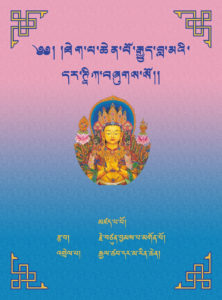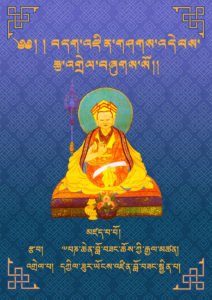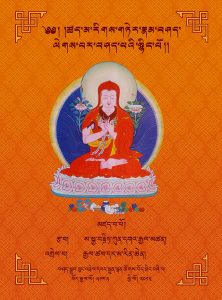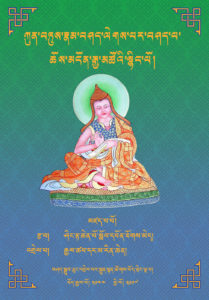Our completed projects can be downloaded in ePub and PDF format from the Download page.
- Gyaltsab Je Darma Rinchen’s Commentary on Maitreya’s “Uttaratantra,” printed 2013.
- Panchen Lobsang Chokyi Gyaltsen’s Debate Between Wisdom and Self Grasping along with its commentary Banishing Self-Grasping by Tutor Lobsang Jinpa, printed 2014.
- Gyaltsab Je Darma Rinchen’s An Ocean of Reasoning that Eliminates the Torment of Grasping at Extremes, a commentary on Dignaga’s Pramana-samuccaya, printed 2015.
- Sakya Pandita’s root text Treasury of Reasonings on Valid Cognition and its commentary Essence of Excellent Explanations by Gyaltsab Je Darma RInchen, printed 2015.
- Arya Asanga’s root text Abhidharma-samuccaya and its commentary The Essence of the Ocean of Abhidharma by Gyaltsab Je Darma Rinchen, printed 2017.
It is worthwhile to say a small word about Gyaltsab Je Darma Rinchen, as his commentaries figure heavily in our completed works.
Gyaltsab Je was one of Tsongkhapa’s two heart disciples, (with Khedrub Je being the other). Gyaltsab Je’s thought is considered to explain the final thought of our tradition’s founder, the Great Tsongkhapa, on many topics, including those within Perfection of Wisdom studies and also the Valid Cognition studies. So for this reason his works serve as the foundation for most of the various textbooks used in any of the great Monastic Universities, such as Sera, Ganden, and Drepung. However, until very recently (2015) that there was any computer-input version of his collected works was produced, and that version, which is included in The Collected Works of the Lords Father and Sons (the combined collected works of Tsongkhapa and his two heart disciples Gyalstab Je and Khedrub Je), is not readily available for either download or purchase. For this reason sharing and producing clear, critical editions of his texts, and making them widely available, is quite important in and of itself. However there are two points that compound the importance of these types of publications.
The first is that some of his texts, such as his commentary on Sakya Pandita’s Treasury of Valid Cognition, are not actually included within his collection works. There historical reasons for this are not entirely clear, but some suggest sectarian tensions that existed at the time of compiling his collected works which no longer exist. Regardless, any complete collection of complete corpus necessarily needs include works that don’t exist within his official collected works. The second reason that producing and publishing these texts in this way is important is because these particular texts are commentaries on other works, and so we have produced “interwoven” publications which include the root text within the body of the commentary. This type of formatting is near impossible using the traditional Tibetan pecha, or thin, rectangular loose-leaf publications. Additionally, until the late 20th century all texts produced in Tibet were either handwritten or carved into wooden blocks, and the time and expense of including the root text was mostly prohibitive (of course, a few such interwoven texts do exist from pre-modern Tibet, but they are rare). Yet there is so much to be gained by having both the root text and commentary published together! It is much easier to follow the commentator’s process and development of thought, and it simultaneously grants access to the root text in a way that is difficult when you are trying to juggle various different texts and determine which sections comment on which. The opportunity to study a root text interwoven within its commentary is a true boon to students, and so that compounded our interest in making these texts available in this format.
 A Commentary on [Lord Maitreya’s Uttaratantra,] that Treatise which Explains the Intent of the Mahāyāna Sūtras of Definitve Meaning
A Commentary on [Lord Maitreya’s Uttaratantra,] that Treatise which Explains the Intent of the Mahāyāna Sūtras of Definitve Meaning
by Gyaltsab Je Darma Rinchen
This text, an extensive commentary on Maitreya’s root text Uttaratantra, is important for a few reasons. It is helpful not only for the four years of Middle Way philosophical studies, but also for the seven years of Parchin (Pāramitā) studies in general. The text’s main topic of buddha-nature (dezhin shegpäi nyingpo, tathāgatagarbha), based on the mind’s emptiness of true existence from a Prasangika viewpoint, is explained in great detail. It is developed upon the basis Arya Maitreya’s root text, which His Holiness the Dalai Lama often refers to when explaining which bases that are suitable to, with repeated habituation, later transform into the bodies of a buddha. This is because this text also includes extensive explanations on the four bodies of a Buddha and their qualities, as well as an uncommon presentation of the three jewels in general, and especially of the concept of resultant refuge. Return to Top
 Debate Between Wisdom and Self Grasping along with its commentary Banishing Self Grasping
Debate Between Wisdom and Self Grasping along with its commentary Banishing Self Grasping
by Lobzang Chökyi Gyältsen and Tutor Lobzang Jinpa
His Holiness the 14th Dalai Lama has, on more than one occasion, expressed the importance of this root text and its critical explanation of the proper view of emptiness, going so far as to say, during an oral transmission of it to an assembly of more than 5,000 monks at Gyume Monastery in 2013, “If it wasn’t for this text, I probably would have become a follower of the Svantantrika-Madhyamaka (Autonomous Middle Way) school [as opposed to the Prasangika-Madhyamaka (Consequentialist Middle Way) School which is considered the only school to teach the final and correct view].”
The included commentary Banishing Self Grasping: A Detailed Commentary on Debate with Self-Grasping, appears to be the only extant commentary on the root text to exist. It was authored by the great Tutor Lozang Jinpa (1821-1891) of Tashi Lhunpo, a respected author in the Geluk tradition whose former incarnation, Yongzin Lozang Tenzin, was prophesized as an emanation of Je Tsongkhapa himself. The opportunity to have access to such a scholar’s commentary in full alongside the root text is invaluable to understand many of the complicated points about very subtle phenomena.
The comments by His Holiness along with a recognition of how few scholars have access to a copy of the work (until very recently the root text was not available in book format, and those that have been printed are very limited in number, and the commentary and root text seem to have never before been published together) served as the primary inspiration for this project. One English translation of the text can be accessed online at Happy Monks Publication,and a different one was published by Motilal Banarsidass. Return to Top
 An Ocean of Reasoning that Destroys the Torment of Grasping at Extremes, a commentary on Dignaga’s Pramana-samuccaya
An Ocean of Reasoning that Destroys the Torment of Grasping at Extremes, a commentary on Dignaga’s Pramana-samuccaya
by Gyaltsab Je Darma Rinchen
Gyaltsab Je’s Ocean of Reasoning is surely the foremost commentary on the great Indian logician Dignaga’s Pramanasamuccaya from within the Gelug tradition, (and perhaps Tibet). Regarding the root text, the Great Dharma Lord Tsongkhapa’s Expression of Realization: Destiny Fulfilled says of this classic work, “One should take as authoritative the direct instruction bestowed on Dignaga by Mañjushrī, saying explicitly that “Compose this (Pramanasamuccaya)! In future times this will become an eye for all migrators!”, and, also, “Investigating deeply the procedure therein, I developed a deep-seated conviction about the import of Pramanasamuccaya; That the Lord (Buddha), as a personification of reason, is authoritative for the seeker of liberation because of (his unerring description) of evolution and cessation, and that therefore His teaching is the only haven for those desiring liberation.”
Thus, this absolutely essential work constitutes the very root of all of the later works following the Glorious Dharmakirti’s Pramanavarttika (Commentary of Valid Cognition), and as such the key source for the presentations of: the reasoning establishing future lives, the possibility of liberation from karma and delusions, refuge and the four noble truths, and more. His Holiness the Dalai Lama again and again expounds these topics on this basis in his introductory teachings, while praising the Tibetan tradition’s historical and continued emphasis on studies of this crucial field as principal uncommon feature of the system. Return to Top
 The Essence of Excellent Explanations, an explanation of (Sakya Pandita’s) Treasury of Valid Cognition
The Essence of Excellent Explanations, an explanation of (Sakya Pandita’s) Treasury of Valid Cognition
by Gyaltsab Je Darma Rinchen
Gyaltsab Je Darma Rinchen’s The Essence of Excellent Explanations is much quoted in the Valid Cognition explanations and monastic textbooks composed in Tibet, but incredibly rare in as much as it was left out of almost all editions of Gyaltsab’s Collected Works. This scarcity of this text’s publication is in no way, however, a sign of its diminished significance.
Based on his Treasury of Valid Cognition, which was pivotal in elevating Dharmakirti’s Commentary on Valid Cognition (Pramana-vartika) to the central focus of logico-epistemological studies, Sakya Pandita Kunga Gyaltsen is arguably the most important historical Tibetan thinker in the field of logic and epistemology. It is through Gyaltsab Je’s commentary that his importance for the Geluk school is most strongly and clearly emphasized, and the first Dalai Lama, in all of his own works on valid cognition, referenced it as the pivotal interpretation of Sakya Pandita’s work.
Sakya Pandita, who studied at the feet of great Indian masters, came to the conclusion that several of the previous views that Tibetan thinkers had attributed to the great logician Dharmakirti misrepresented that master’s true thought. On this basis he composed The Treasury, which remains a Tibetan classic, as exemplified by His Holiness Dalai Lama’s direct advice for those studying to read and rely especially on The Treasury in their studies of Buddhist epistemology. Indeed, Gyaltsab Je beautifully expresses his respect for Sakya Pandita in the homage that begins his commentary:
Through having seen the depths and extremities of the ocean of reasoning,
And possessing the perfect thought which destroys the darkness of unknowing,
You became the supreme of guides to world system’s gods and humans:
I bow with respect to the feet of the Glorious Sakya Panchen!
Every winter the monks from all of the great Geluk Monastic Universities come together to study and debate the difficult points of the epistemological tradition as presented by the Indian masters. Sakya Pandita’s text, quoted and referred to in almost all of the relevant monastic textbooks, serves as a critical foundation for this winter debate season, and Gyaltsab Je’s commentary serves as an equally critical lens which focuses the meaning of Sakya Pandita’s thought clearly and precisely. Our edition includes both texts in full, interwoven together so the student can simultaneously engage the root text and the commentary with ease Return to Top
 The Essence of the Ocean of Abhidharma, an Excellent Explanation, a commentary on Arya Asanga’s Compendium of Higher Knowledge (Abhidharma-samuccaya)
The Essence of the Ocean of Abhidharma, an Excellent Explanation, a commentary on Arya Asanga’s Compendium of Higher Knowledge (Abhidharma-samuccaya)
by Gyaltsab Je Darma Rinchen
The root text was written by Arya Asanga, and forms the basis of the “Higher Knowledge” or Abhidharma of the Mahāyāna tenet system. It covers such diverse topics as the Four Noble Truths, the twelve links of interdependent origination, the thirty-seven limbs in harmony with enlightenment, and a description of minds and mental factors, among other topics, covering all of the foundational materials from which the further topics of study develop. Gyaltsab Je Darma Rinchen’s commentary is one of only a very few commentaries composed on this text within Tibet, and it is celebrated by all contemporary schools and lineages of Tibetan Buddhism as being a clear and profound addition to the abhidharma tradition. Both root text and the commentary are often quoted in the texts related to the Perfection of Wisdom (Prajnaparamita) studies, and as such being able to access and study them brings the student deeper into the minds and understanding of these topics and the scholars who wrote on them. Unfortunately, due to the extreme rarity of Gyaltsab Je’s text–it has only been printed once in India, a 500-copy print in 2001–most scholars are not able to study it easily. As far as we can determine this is the first time the root text and its commentary have been printed in an interwoven style, which makes study even more accessible, and we are happy to make this important resource more widely available. Return to Top
